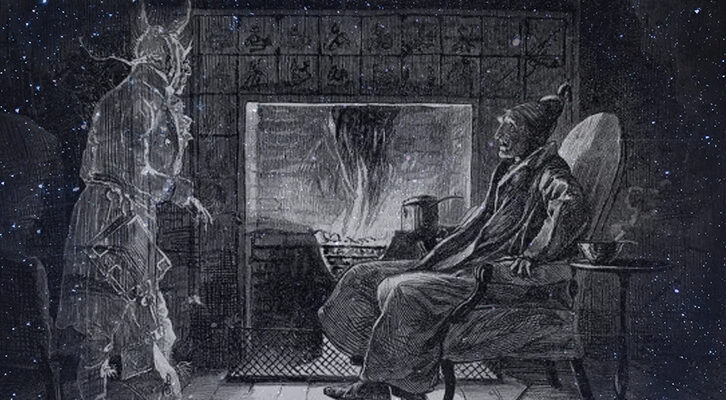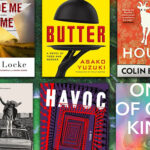Two Decades of Reading Beside the Woman I Love
They Met at a Bookstore and Have Been Reading Together Ever Since
My relationship with Libby began between piles of books at the independent bookstore in Denver where we both worked. We were in our twenties, and soon after we started dating we found ourselves standing together in front of the shelves in our respective apartments, eager to use books as a way to reveal our rich inner lives to each other. With her pocket-sized copies of Rumi, oversized collections of Dada collages, and a broad taste in novelists, Libby’s personal library was particularly enticing. We read a lot of the same fiction, and she had already been working at the bookstore for four or five years at that point, so when we stood before the shelves at my place I had to reach deep to impress her. To do so, I retrieved books on iconography and snake handling, plus a few stirring poets. Apparently, it worked.
From the start, books have been fundamental to our relationship, but we’ve always approached the process of reading quite differently. Libby’s bedside table, then and now, has always been tidy, holding two or three titles that are in rapid circulation. It’s a conveyor belt of new books, remarkable in its turnover and efficiency. This makes sense: She is a bubbly human being, full of energy, zipping from one endeavor to the next with subdued cheer. A dream reader, she reads a lot of books, and she reads them fast.
On the other hand, the only nickname I’ve ever had that stuck is Lagger, as in, “Let’s go already, Lagger,” or, “You made us miss the bus, Lagger.” I was a virtuoso of the slow movement long before it became a topic of parenting and foodie books and a general antidote to hectic contemporary life. My reading habits have always reflected this decelerated metabolism. As Libby’s bedside books are making their entrance onto a shelf or diving through the library’s bookdrop, the books on my nightstand are growing algae and roots. My bedside pile sometimes towers so high, in fact, that venturing into it is like a panicky game of Jenga. At least once a week, a stray book takes out a bedside glass of water, yet I stand firm in the delusion that I will, with enough time, get through them all.
*
Four years into our relationship, both Libby and I began to express mild interest in leaving the bookstore and Colorado to go back to school. She wanted to study Library Science on the East Coast, and I wanted to pursue a degree in Creative Writing in the rural West. It was all very theoretical until the day Libby came home with a book called Graduate Schools in New England. The sight of it stung a little bit, so I responded with a short story collection: In the Loyal Mountains.
She raised the ante: Careers in Library and Information Science.
Me: Blue Highways.
Libby: Boston on a Budget.
Me: The Roadside Geology of Idaho.
For the next three years, we lived 3,000 miles apart but managed to keep our relationship alight. When we were finished with grad school, we got married. As a wedding gift, two different friends gave us copies of Pablo Neruda’s 100 Love Sonnets.
After our wedding, our shared collection of books grew in quantity and quality—until pregnancy titles started showing up. Then, when we suddenly had less time to read than any other period in our lives, came the onslaught of parenting books. A dog-eared copy of Attachment Parenting replaced our Lonely Planet guides as we made room in our bed for two little ones.
Libby and I met while shelving in the children’s section, so we had a fair amount of kids’ books that we’d picked up, pre-kids, because of the story (Amazing Grace) or the design (The Happy Hocky Family) or just pure, weird genius (Saranohair). Once our boy and girl got past the eating pages stage, they began to devour books in other ways, and suddenly, we had a whole new range of shelving issues. Fabric books. Books that required batteries. Books with stickers, then books with no stickers because the stickers were all over the walls. Our parenting guides hadn’t warned us about this.
Reading picture books to a pair of toddlers had an equalizing effect on our reading speeds. A small hand planted on an illustrated page to prevent it from turning was enough to slow Libby way down, just as frantic little fingers flipping to the end were enough to push me into overdrive. It was amazing how many details would emerge on a single page of Graeme Base’s Animalia or Richard Scarry’s Busy, Busy World when we’d stare at it for 20 minutes—thighs going numb, drool drying on our wrists—just as it was amazing how many Curious George stories we could plow through in 20 minutes when the kids were on a tear.
Libby and I emerged from our kids’ toddlerhood feeling like one of those technicolor couples leaning into each other at the end of a dance-a-thon. Year to year, as our collection gradually absorbed a tsunami of beginning readers (Poppleton the pig, Bing the bunny), chapter books (Ivy + Bean, Clementine), comic books (Moomin, Archie), middle grade fiction (Beast Quest, My Father’s Dragon), young adult titles (The Rithmatist, Out of My Mind), and graphic novels (Amulet, Ariol), we began to accumulate some perspective on raising readers. We learned to rarely say no, for example, when our kids wanted us to buy them books—there are enough obstacles to reading without adding parents to the list—and to make a point of spending family time in bookstores everywhere we traveled. We’ve been flawed parents, as all parents are, but I’m pretty sure we got that part right.
The teenaged titles that have recently entered the mix—Game of Thrones, The Diary of a Young Girl, Watership Down—inevitably bring forth images of their future bookshelves in dorm rooms or apartments or homes. And while there’s something hopeful about imagining our kids’ own collections growing and merging with others’ over time, there’s also a familiar feeling of wanting to plant my hand on the page—to make everything slow down.
__________________________________
Matthew Sullivan’s debut novel, Midnight at the Bright Ideas Bookstore, is available now from Scribner.




















